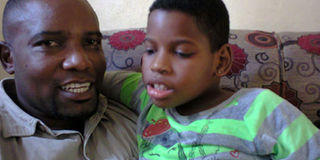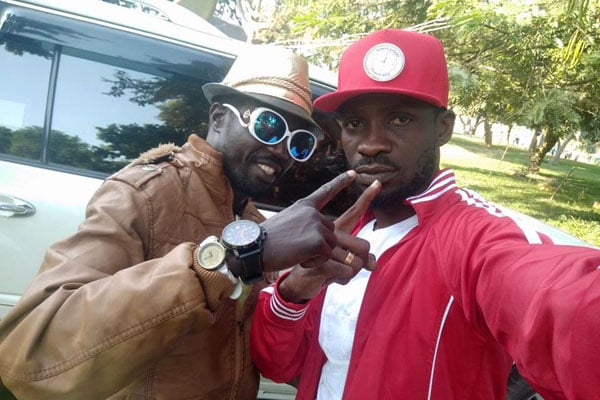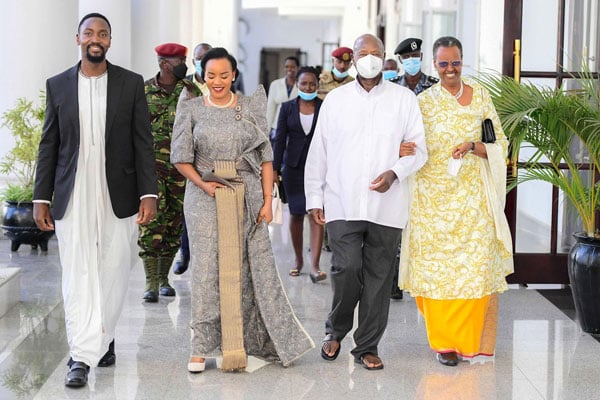What I learnt from raising and losing my daughter to celebral palsy

David Mporampora, a general practitioner, tried to have a normal life with his daughter who was born with celebral palsy, a congenital disorder that impairs development. Sadly, she passed away last year. COURTESY PHOTO.
“When she was pregnant, my daughter’s mother got a blood clot in her right leg due to hormonal imbalance. A scan done at Mulago hospital revealed that the clot had moved up to around her mid back and blocked the major veins which nourish the foetus with blood. She was, however, put on medication and was able to carry the pregnancy to full term.
1. The earliest signs
Low birth weight
Olga Tusiime was born on February 3, 2005, through normal delivery. But at birth, the baby looked malnourished with “loose” skin, like someone who was initially big but lost weight.
Umbilical Cord
Unlike a normal newborn’s cord, Olga’s cord presented as two thin blood vessels which snapped as they pulled her out.
Slow development and spasms
Between birth and six months, she looked normal and was gaining weight as expected. But at about six months, we noticed that you could not get a social smile from her, she could not sit and she started getting spasms. When we saw a paediatrician at seven months, he suggested that we see a neurologist at Mulago.
Seizures
She also started getting seizures so the doctor we saw at Mulago compared the results from the tests and the seizures and told us she had epilepsy. I was not surprised or worried because I also had epilepsy as a child and so did my sister but we both outgrew it and I knew the same would happen to Olga.
But even with this knowledge, the first two years of her life were hard because unlike my sister and I, Olga’s seizures were very bad.
I’m a health worker so I have seen people die and that’s how Olga would be whenever she got a seizure. Her eye would dilate, her body became stiff, clench her teeth and shake violently.
I always had to make sure that she sleeps with someone who would put her in a good position whenever she got an attack. But the doctor never told me outright that Olga had cerebral palsy until I brought it up when she was four years old.
I was sad but also relieved because I knew then what I was dealing with exactly.
2. The challenges
Absent fathers
I met many children with Celebral palsy in my journey with Olga and I recall that it was always the mothers with them at hospitals. I once met a mother who told me, “My child’s father sent me away. He says they don’t produce such children in his family.”
Many times when I was seen carrying around a child old enough to move on her own, I was told my problem required a witch doctor not a medical doctor. I figured witch doctors have agents in Mulago.
3. The lessons
Rehabilitate them
Children with special needs have the capacity to eventually grow and become adults if they are given the right care. The earlier you start providing and rehabilitating them to become independent, the better. Otherwise you are going to get an adult who cannot support themselves.
I got someone to make a special chair for her so that she could learn how to sit on her own and they also made a common seat (a chair with a hole in the middle) which we used for her potty training.
Don’t isolate or hide them
We were able to get help from friends because we did not hide or keep her to ourselves. Whoever came home realised we had a challenge that needed to be shared. Everyone felt for her and offered us social and financial support.
Identify the child’s strong point
One of Olga’s strong point was high pitched sounds or music. I found this out when I went with her to our farm in Fort Portal. I put her under a tree and moved around the farm. When I came back, I found her laughing at bird sounds from the tree.
I also realised that whenever I would drive her around on days when she became irritable, she would keep quiet, relax and sleep. Her therapist told me it was because of the music on the radio. Finding her strengths will help you find the appropriate therapy.
Love them
The easiest way of living with such children is by loving and appreciating them. Whenever Olga would complain, I would never ignore her. I would always leave whatever I am doing and talking to her. At times I would travel from Fort Portal to Kampala just because Olga had refused to eat food.
These children need extra care. You need to bath them, feed them, keep them clean and also talk to them even when you know they will not give you feedback.
4. Management
Seek help
I moved with my daughter to all the special needs children places you have heard of seeking whatever help I could get until I learnt of Tunaweza in Kiwatule. She was five years old then and she improved greatly after she started therapy with them.
Make life easy for them
We designed everything she had to use because we had to train her to do everything such as sitting, communicating, to reach out to something because while she could. At Tunaweza, she did Speech therapy, physiotherapy and hydrotherapy which were meant to release her muscles because they were somehow tight.
Control the symptoms
To control her epilepsy and seizures, we made sure she took her medication on time, kept off infections or malaria. We tried to keep her calm because irritability triggered the seizures yet severe attacks retarded her.
Train them
Every morning when she woke up, we would put her on the toilet. Whenever she wanted to ease herself, she would make some noise and she would be taken to the toilet. This helped reduce the cost of diapers.
Talk to them
We used to talk and somehow I would make sense of the funny noises she would make. At times, I would just look in her eyes, observe her gestures and behaviour and I would understand what she was telling me.
Find therapy
At five years, I took her for therapy. We first went to Fort Portal Referral Hospital, then the physiotherapy unit in Mbarara.
By then, I had gone back to school because I needed to learn more about her condition. After we had done a few course units in neural anatomy, I realised that we had been unfair to this child because she could still learn so much. I was able to understand the gap and her challenge very well.
That is when I decided to take her to Kampala to get better services. I brought her to Tunaweza Children Centre in Kiwatula.
6. Communicating
At Tunaweze, she developed intellectually because she could asses a situation and know to scream until someone came to help her if she thought there was danger. She could feed herself. If she was in the wheelchair and wanted to get somewhere, she could shake it until she got there.
If she was seated at the table and there was a toy she wanted to reach out for, she would pull the table mat until she pulled the toy close to her.
She could not talk but she would “complain” by crying and shouting. For the five years she went for therapy, she had started feeding herself, could sit without being supported and crawl. She also used to do hydrotherapy so I used to take her for swimming. It was meant to release her muscles because they were somehow tight.
7. Affording the care
I resigned from two jobs because they were not giving me time for Olga. I decided to take up a government job but I explained to the director of the hospital my challenges and he gave me a convenient schedule.
My life rotated around my special child. When I resigned from employment in private companies, I picked my National Social Security Funds savings, which helped provide for her needs. I also started up a farm in Fort Portal and took up side jobs for an extra income so at times I would work both day and night to make sure that my child had a good life.
During holidays, I would stay with Olga. I would wake up in the morning, bath her, make our breakfast and go with her to work.
I would put her on a mat with her toys in a corner and see my patients as I kept an eye on her. Olga would only complain when her diaper was full, she was hungry and when she wanted a change of environment.
On days when I had volleyball practice, I would go with her to the field, put her on a mat in the corner of the field with her toys and play. All I had to do was explain to her to shout when she needed my attention.
At times, I needed to catch up with friends, so I would stay with Olga until 10pm when she normally went to sleep and sneak out to go and have some good time with friends. I would return at around 2am before she woke up so that she could find me laying besides her when she opened her eyes. Because she was epileptic, we ensured she slept with someone for fear that she would get an attack and choke.
8. Chosing a caretaker
Because we needed to raise a lot of money for Olga’s therapy, we had to work so we needed someone to take care of her. Getting the right caretaker is key.
Train the caretaker
The caretaker had to be trained to take care of this child. So she had to be present at school and see what they were teaching the child so that she could continue the same at home.
Attitude is important
I had to get someone who was willing to be trained and accept to live the life of this child. I looked for someone who had completed Senior Four and could speak English, with the right attitude.
There was a time I found her care taker seated in the sofa, on phone. Meanwhile Olga was complaining. I just walked past her, went to where my daughter was sleeping and when I checked her, her diaper was full of poop and urine. She was very irritable so I run a number of tests on her and she had a Urinary Tract Infection and a fungal infection which were a result of poor hygiene.
I think i lost Olga to negligence
Olga’s death had a lot to do with the caretaker and my negligence. I did not pay the usual attention when choosing her caretakers but I was later told that she used to harass Olga, beat her up, bark at her and never used to give her medication.
I found this out from a friend at Olga’s school, the other caretaker who was staying home and the children who lived around. I found the medication kit full on the day I had to refill it.
A few days after I had fired that caretaker, Olga got a bad convulsion. Throughout the following week, I also realised that the frequency of the convulsions had increased. I called her doctor on a Saturday and he gave me an appointment for Monday. On Sunday, December 13, 2015, Olga got another weird seizure and I had to resuscitate her.
After she had recovered, we went with her for the Green Festival. She had fun with the other children and when we returned, I put her in bed to rest.
She would normally wake up after 30 minutes but I waited 40 minutes and she was not up yet. I went to check on her and when I touched her arm, it was wobbly, which is abnormal.
I felt for her pulse but it was low. The room was dark so I used the flashlight on my phone to check her eyes but the pupils had dilated. I called for help while I kept resuscitating her. She died after about 10 minutes on the way to hospital. She died from complications that resulted from not taking her epilepsy medication.




